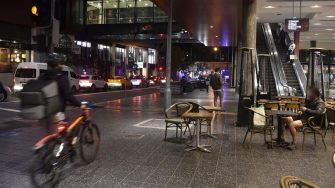
Meet Dr Meead Saberi Kalaee, senior lecturer in the School of Civil and Environmental Engineering at UNSW who has worked on a project to improve the safety of women after dark in Greater Sydney.
His work helps women to navigate safer transport and pedestrian routes at night and also assists city planners and government policy to increase safety within the community. However, just like many of us after school, Dr Meead Saberi wasn’t entirely sure what he wanted to study at uni. He chose Civil Engineering, which led him to transport engineering and exciting research opportunities in this multi-disciplinary field.
We asked Dr Meead Saberi a few questions about Civil Engineering and what he is currently doing in the field.
You’re a senior lecturer in the School of Civil and Environmental Engineering at UNSW and also leading the CityX research lab as part of the Research Centre for Integrated Transport Innovation (rCITI); how did you become interested in this field?
When I finished high school, I wasn’t sure what field I’d like to study at university. My brother chose to do Civil Engineering before and my best friend at the time also decided to do Civil Engineering. So, I thought maybe I’d also like to do Civil Engineering. When I finished my bachelor’s degree, I wasn’t sure if it was the best decision that I made. I had the chance to do a few courses in transport engineering that really got my interest.
Transport engineering is a sub-field of Civil Engineering. However, transport is also a very multi-disciplinary field with social scientists, computer scientists, geographers, physicists, and urban planners all working and contributing to it. I really enjoyed this multi-disciplinary aspect and I decided to continue my postgraduate studies in transport. I was also very much enjoying the challenges that research in new areas bring about. I had to work on problems that there was not necessarily an answer available for it. That got me into academia, and I ended up as an academic at UNSW.
You’ve recently partnered with Cardno and Transport for NSW on a new Safety After Dark initiative for women. Could you tell us more about this project?
About a year ago, Transport for NSW announced an innovation challenge on safety after dark for women. Transport for NSW was interested in trialling innovative data and technology ideas to improve safety for women travelling on transport at night in Greater Sydney. The posed question was: 'How might we use data and insights to inform decisions and put in place actions to make travelling in the city safer for women at night?'
I partnered with a few colleagues at Cardno and developed a proof of concept for a Passive Surveillance Index (PSI) for streets. Passive surveillance reduces opportunities for crimes to occur and improves the perception of personal safety. The PSI used experiential data obtained from women who regularly use the area to feed into a machine learning model that predicted the level of passive surveillance for urban streets.
The application of the data that we collected was extensive, and we analysed it for two key functions:
To inform personalised wayfinding for safer/ evening friendly walking routes; and
A powerful tool for city planners to inform investment and policy decisions.
Check out the outcome of this project and colour-coded map showing safer walking routes!
What is the most rewarding thing about the work you do?
That our solution could make some women feel safer and allow some of them to participate more freely in the community at night.
Beyond this project, I think the most rewarding thing in academic work is the impact that I can have on each student, deciding what do in their career after university.
Finally, what advice do you have for high school students interested in Civil and Environmental Engineering?
Civil and Environmental Engineering includes many different and diverse sub-fields such as transport, water, environment, structure, geotechnic (science of soil), surveying engineering and construction management. I think there is something for everybody in Civil and Environmental Engineering. You will have the opportunity to choose any sub-field of your interest in the future to learn more about it and become an expert it.
The work that civil and environmental engineers do is something that affects people’s daily lives, whether we look at buildings we live and work in, or the water that comes out of the tap and the transport system that we move on to get around the city.
With the climate change crisis, civil and environmental engineers also have a huge responsibility to ensure what we design and build help the world in reducing the greenhouse gas emissions. Social equity and equality is another aspect that civil and environmental engineers could also have a significant impact.
